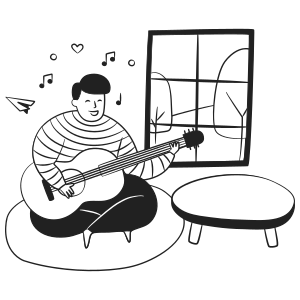In these reflections, I wanted to share with you some of my best tips to be productive and feel great while working from home.
You’ll find:
- How to be productive at home (and avoid procrastination);
- Some tips to create a great home workspace;
- Ideas to keep yourself healthy when you work remotely;
- How to look after yourself, your mind, and your mental health.
If you’re looking for ideas to improve your work routine at home, you’ll enjoy the read.
Let’s dive in!
Section 1: Boost your productivity
Working from home brings a lot of benefits:
- No commute.
- More autonomy.
- Heads-down time.
- Seeing your family.
- Managing your house admin.
But having a home office also comes with the big challenge of being productive.
Let’s see what we can do to overcome that.

1. Create your to-do list for the day
In the morning, define your key outputs for the day. Start with the end result in mind. What do you want to be done by the end of the day?
What we want to avoid: Procrastinating. Getting distracted. Not knowing what to do first. Feeling overwhelmed. Not being clear on why we’re doing something.
A method:
- Track your project – I track the workflow of my projects in Trello. It allows me to have a clear view on what will need to be done in the coming days or weeks. It is especially useful when I work with a team or have multiple projects to manage in parallel.
- Review every morning – Every day, I prioritise the two to four key things I want to get done in the day. I do this either in a stand-up meeting with my team or by myself when I work on a personal project.
- Break it down into smaller tasks – Once I’ve set what I want to see as a result of my day of work, I break it down into smaller tasks I can track during the day. (This allows one to be clear on what needs to be done. It makes it feel more achievable and helps keep the motivation going.)
- Keep your to-do list visible – I write the tasks on a Post-it note that I put next to my computer. This is my tip to avoid losing focus on what I want to get done. Every time something is done, I cross it off.
A caveat: Planning is important. It gives you focus. But in reality, you’ll get interrupted. Things may happen and change the course of the day. As the day progresses, I reassess regularly what’s important and what’s urgent. It helps me prioritise the things that I hadn’t planned.
2. Set limits between work and home
Find the right balance between work mode and home mode. And set the limit.
A big challenge: When working at home, you may end up constantly connected to your work. It makes it so easy to say that you’ll “finish some stuff after dinner”. You’re also more likely to get distracted, especially if you feel you’re going through an endless series of tasks.
Some solutions:
- Compartmentalise your day – Be clear when your work day starts and when it finishes.
- Estimate how long each task is going to take you – Having a rough idea of how long it takes to do something will help you keep your focus. I try to break down my workflow in tasks that take me less than an hour. Crossing something off my to-do list helps to keep me motivated.
- Block time in your calendar for each activity – Having a to-do list helps me track what I have to do. Blocking time in my calendar helps me track how long I can afford to spend to get it done.
Section 2: Look after your home environment
Our environment influences our behaviour. Over the long term, it is much stronger than our willpower.
Pay close attention to the design of your workspace and your daily routine.
Let’s see how you can create a positive work/home environment to keep yourself healthy and productive.

3. Tidy up your workspace
When you’re done with your day, pack away your work (e.g. laptop, phone, folders).
Clean your desk. Tidy up the room where you’ve been working. Make it clear that your work day is over.
Why it matters: When you work from home, it’s hard to disconnect. Packing away your work stuff signals to your brain (and your family) that work time is over. You can now focus on having fun (and your family knows they can now fully be with you).
A method:
- Turn off your computer – At the end of the day, I close all the apps that are open in my computer. It forces me to wrap up with all the things I’ve been doing.
- Pack away – Then, I pack my laptop in my backpack–as if I was going to leave the office. (If you can, find a place where to store your work devices so they won’t be visible.)
- Tidy up – I also tidy the room where I work. It is a nice routine that makes the rest of the evening more peaceful for my mind.
4. Wear your work outfit, even at home
A friend told me about her dad–a lawyer–who would suit up every morning, even when he worked from home.
I thought it was overkill. But it’s actually a good way to get yourself in the flow.
Some benefits:
- It signals to your brain that you’re in work mode, which helps to stay focused.
- It makes it clear for your family that the day has started, which means less risk of being interrupted.
- This is also a way to pump up your sense of self-discipline.
A habit to adopt: When you start your day, instead of working in your pyjamas, take a shower and get dressed, wearing what you would wear if you had to go to the office.
5. Schedule your spare time
Again, it’s easy to fall into the trap of never switching off when you work at home.
It’s important to set time aside to relax, catch up with friends and family, and pursue your hobbies.
What to do:
- Plan ahead – I make sure I’m being intentional with my spare time. This helps me do things that I really enjoy (and avoid defaulting to watching series or browsing Instagram).
- Schedule your spare time – I try to book most things in my calendar. It allows me to guarantee that there will be time for proper leisure.
- Don’t overplan – I don’t create a detailed plan for everything I do. I just make sure that I block some time to relax.
Section 3: Keep moving, especially at home
Working from home is the ultimate example of a sedentary lifestyle.
So when you’re staying at home all day, you need an extra push to get yourself moving. It’s also important to take care of your posture as you work.
Let’s see how to take care of your body.

6. Invest in your home set-up
When you work at a desk for hours, you need to make sure you have a good posture. For this, you need to set your home workspace ergonomically.
Why it matters: You want to take care of your neck and back. Staying eight hours sitting in the wrong posture may create a lot of stress on your vertebral column. This may lead to discomfort and ongoing pain.
What to do:
- Keep your neck straight – If your screen is too low, you’re going to have a forward-head posture, which can be painful for your neck. Elevate your screen using a laptop stand.
- Invest in a good chair – The right chair isn’t too high or too low. It encourages you to sit straight and doesn’t put too much pressure on your glutes. (Some people even use a stability ball, as it forces you to adopt a good posture.)
- Stand up as much as possible – I rarely work sitting. I find that working standing up is the best for my back, glutes, and neck. It’s also the best way to keep my energy up throughout the day.
- Switch position regularly – Go from sitting straight to standing up. You don’t want to be stuck in the same position for hours.
- Stay away from your bed or sofa – Sitting or laying down on a bed or sofa is the worst thing you can do for your back. There’s no way you’ll be able to adopt a good posture. It’s also a bad signal for your mind.
Recommended gear:
- Standing desk (link) — It helps keep a good posture.
- Laptop stand (link) — It encourages you to keep your neck straight.
- Mechanical keyboard (link) and ergonomic mouse (link) — This is to keep your wrist in a good position.
- Good earphones (link) — You want to protect your ears as much as possible with good quality sound.
7. Push yourself for a daily workout
When you stay at home, it’s so easy to end up not moving for the entire day. To compensate for that, I make sure that I push myself to workout every day.
Why it matters: Moving makes you happier. It helps you stay focused and sleep better. It’s also an effective way to disconnect and stop worrying.
Some tips:
- Find a type of workout that you enjoy doing – This is the most important: whatever workout you plan to do, it should be enjoyable. Otherwise, you’ll do it twice and then you’ll stop.
- Use online courses – YouTube is full of free gym classes (e.g. many friends recommended Yoga with Adriene). It’s a good way to find a nice workout routine.
- Listen to motivating music – Music gets you going. It’s a powerful motivator.
- Get a workout buddy – Having someone checking on will help you keep yourself accountable.
- Track your progress – Track your steps, the number of reps, time spent working out… It feels rewarding. And try to do a little every day. Don’t to break the chain (link).
Useful equipment for a home gym:
- Yoga mat (link)
- Push-up stands (link)
- Abs wheel (link)
- Exercise ball (link)
- Fitness stepper (link)
- Resistance bands (link)
Implementing in your routine: Find the right time for exercising. I tend to do exercise at the end of the day. This is when my body needs to release energy. It also helps quieten my mind after hours of stimulation.
Section 4: Mental health at home
We tend to worry so much about being productive that we often neglect our mental balance.
Here’s some advice to look after your mind when you work from home.

8. Take short active breaks
Your brain needs breaks. It cannot sustain 8 hours of constant stimulation.
I bet that when you feel mentally exhausted, you didn’t take mini-breaks during the day.
Some ideas to relax:
- Going for a five minute walk outside to get some fresh air.
- Walking up and down the stairs for a couple of times.
- Taking 40 seconds to do push-ups or squats.
- Pausing and concentrating on your breathing for 30 seconds.
9. Keep your mind at peace
I was initially very sceptical about meditating. It seemed too hippie to me. Well… I was wrong.
Benefits: Meditating is a good way to relax, kill stress and anxiety, and make yourself more aware of your thoughts and feelings.
When to mediate: I tend to follow a guided meditation at the end of a busy day. It helps quiet my mind, and get some focus and energy back for the evening.
Some free guided meditations:
- Insight Timer (link) – A meditation app where instructors share their guided meditations.
- Tara Brach (link) – So far, I have really enjoyed the meditations guided by Tara Brach.
- UCLA Mindfulness Center (link) – A free database of guided meditations.
Books to read about mediation: Meditation may sound daunting at first. It’s worth reading a book about it to get into it. These four books are very accessible:
- 10% Happier by Dan Harris
- Radical Compassion by Tara Brach
- Waking Up by Sam Harris
- The Science of Meditation by Daniel Goleman
Like what you're reading?
Click here to subscribe to Progress.
It’s a monthly newsletter where I share reflections like this.
You may also like the following reflections: